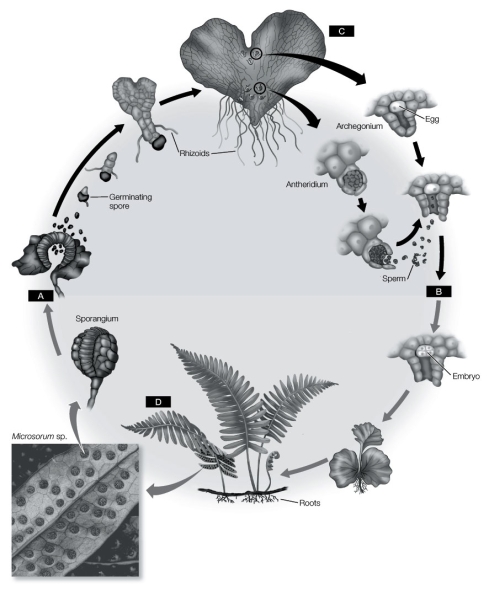A) evolved a number of times.
B) is found only in the most advanced land plants.
C) is simpler than homospory.
D) is found in the most primitive land plants.
E) evolved along with swimming sperm.
Correct Answer

verified
Correct Answer
verified
Multiple Choice
In some liverworts, there are structures that "throw" _______ from the capsule.
A) moisture particles
B) spores
C) sperm
D) ova
E) rhizoids
Correct Answer

verified
Correct Answer
verified
Multiple Choice
Which of the following is not a characteristic of land plants?
A) Development from embryos protected by tissues of the parent plant
B) Cell walls containing cellulose
C) Chloroplasts containing chlorophylls a and b
D) Starch as the storage carbohydrate
E) Anaerobic respiration
Correct Answer

verified
Correct Answer
verified
Multiple Choice
Which of the following characteristics is not shared by the club mosses and the horsetails?
A) Large, independent sporophytes
B) Specialized vascular tissue
C) Apical growth
D) Simple leaves
E) Both b and c
Correct Answer

verified
Correct Answer
verified
Multiple Choice
Which statement is not true of the mosses?
A) The sporophyte is dependent on the gametophyte.
B) Sperm are produced in archegonia.
C) There are more species of mosses than of liverworts and hornworts combined.
D) The sporophyte grows by apical cell division.
E) Mosses are probably sister to the vascular plants plus hornworts.
Correct Answer

verified
Correct Answer
verified
Multiple Choice
Which of the characteristics below links the "green algae" with land plants?
A) The use of chlorophylls a and b
B) Active stomata
C) Starch as a major storage compound
D) Cellulose in cell walls
E) a, c, and d
Correct Answer

verified
Correct Answer
verified
Multiple Choice
Which of the following represents the most ancient surviving land plant lineage?
A) Liverworts
B) Hornworts
C) Mosses
D) Ferns
E) None of the above
Correct Answer

verified
Correct Answer
verified
Multiple Choice
In alternation of generations, the sporophyte generation is _______ and the gametophyte generation is _______.
A) haploid; diploid
B) diploid; haploid
C) haploid; haploid
D) diploid; diploid
E) either haploid or diploid; either haploid or diploid
Correct Answer

verified
Correct Answer
verified
Multiple Choice
In nontracheophytes, the larger plant is the _______, while in tracheophytes, the larger plant is the _______.
A) gametophyte; sporophyte
B) sporophyte; gametophyte
C) gametophyte; antheridium
D) sporophyte; antheridium
E) antheridium; archegonium
Correct Answer

verified
Correct Answer
verified
Short Answer
Use the following to answer questions :
Refer to the diagram below.  -Which letter in the diagram indicates the sporophyte, C or D?
-Which letter in the diagram indicates the sporophyte, C or D?
Correct Answer

verified
Correct Answer
verified
Multiple Choice
Most ferns are homosporous. Which of the following ferns are heterosporous?
A) Salviniaceae
B) Rutaceae
C) Marsileaceae
D) Both a and b
E) Both a and c
Correct Answer

verified
Correct Answer
verified
Short Answer
Use the following to answer questions :
Refer to the diagram below.  -Are the gametes in the diagram produced by mitosis or meiosis?
-Are the gametes in the diagram produced by mitosis or meiosis?
Correct Answer

verified
Correct Answer
verified
Multiple Choice
Which of the following is not a structure or characteristic that enables the nonvascular plants to obtain water and minerals in the absence of a vascular system?
A) Growth in dense masses through which water can move by capillary action
B) Leaflike structures that catch and hold water
C) Small size, which allows minerals to be distributed evenly by diffusion
D) An extensive root system
E) Both c and d
Correct Answer

verified
Correct Answer
verified
Multiple Choice
What are the shared derived characteristics indicated on the phylogeny shown below? 
A) 1: xylem and phloem; 2: chloroplasts; 3: flowers
B) 1: chloroplasts; 2: pollen; 3: flowers
C) 1: pollen; 2: chloroplasts; 3: flowers
D) 1: eukaryotic cells; 2: chloroplasts; 3: flowers
E) 1: eukaryotic cells; 2: chloroplasts; 3: swimming sperm
Correct Answer

verified
Correct Answer
verified
Multiple Choice
Some mosses
A) can carry out limited transport of water and nutrients using cells called "hydroids."
B) contain xylem.
C) contain phloem.
D) can be considered vascular plants.
E) All of the above
Correct Answer

verified
Correct Answer
verified
Short Answer
The sister group to the hornworts is the _______, or vascular plants.
Correct Answer

verified
Correct Answer
verified
Multiple Choice
Plants invaded the land sometime during the Paleozoic era. In order to evolve and thrive on land, plants had to
A) develop photosynthetic pigments and mechanisms for transporting water and minerals to aerial parts.
B) develop starch for carbohydrate storage and mechanisms for transporting water and minerals to aerial parts.
C) develop physical support structures and mechanisms for gamete dispersal.
D) develop photosynthetic pigments that are not dependent on an aqueous environment and develop starch for carbohydrate storage.
E) alternate generations and develop physical support structures.
Correct Answer

verified
Correct Answer
verified
Multiple Choice
Which of the following groups has large leaves with branching vascular strands?
A) Horsetails
B) Whisk ferns
C) Hornworts
D) Club mosses
E) Ferns
Correct Answer

verified
Correct Answer
verified
Multiple Choice
The evolutionary origin of microphyll is thought by some biologists to be
A) sterile sporangia.
B) rhizoids.
C) specialized xylem.
D) photosynthetic tissue developed between complex branching patterns.
E) None of the above
Correct Answer

verified
Correct Answer
verified
Multiple Choice
Approximately _______ species of moss (Bryophyta) have been described.
A) 9,000
B) 15,000
C) 100
D) 1,200
E) 15
Correct Answer

verified
Correct Answer
verified
Showing 101 - 120 of 144
Related Exams